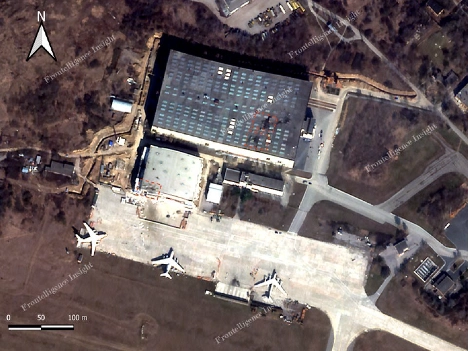An ambitious Ukrainian multiple drone strike against Russia’s military-industrial complex on Saturday penetrated Kremlin air defenses and struck an aircraft repair facility in the western Russian city of Taganrog.
The site is believed to be the location for the repair of the Beriev A-50U AEW&C (airborne early warning and control) aircraft, although it is not clear whether any were there at the time of the attack.
JOIN US ON TELEGRAM
Follow our coverage of the war on the @Kyivpost_official.
Satellite images show that at least one drone had blown holes in the roof of one of the facility’s buildings.
A Russian Defense Ministry statement on March 9 said that Ukraine had launched a total of 47 drones in a series of early morning raids. Forty-one or so of the aircraft seemed targeted against the aviation in Taganrog, but Moscow said it had also shot down drones in Russia’s Kursk, Belgorod and Volgograd regions as well.
Video images and internet reports from the night confirmed that multiple heavy explosions had occurred on the territory of the Taganrog Aviation Scientific Technical Complex named after G.M. Beriev.
The military aviation base is used primarily by the Russian Air Force for repairs and upgrades to large, four-engine jet aircraft, including Tu-95 bombers, Il-76 cargo planes, and the A-50Us – which are Il-76s converted to provide airborne early-warning and command capabilities.
The Ukrainian drones flew at tree-top level, crossing 200 kilometers of Russian-controlled air space before striking Taganrog from the north, according to the Ukrainian independent information platform, censor.net. Russian Telegram channels reported local air defenses fired on the drones with most claiming that most if not all had been shot down.

Drone Attack on Kyiv: Firefighters Extinguish Blazes Caused by Falling Debris
Regional Emergency Situations spokesperson Vasiliy Golubev later announced that an emergency responder had been injured in the strikes.
According to an analysis of satellite imagery by the private research group Frontelligence Insight on March 10, the factory roof was largely intact but showed clear signs of explosions, almost certainly caused by drone strikes. It wasn’t possible to determine if anything inside the building, which could have been one more of the A-50Us, was damaged.
Satellite imagery made on Feb. 29 showed an A-50 parked on the tarmac adjacent to the repair center although 48 hours later it was missing. Other images showed a single S-300 anti-aircraft missile system deployed adjacent to a runway.
Frontelligence Insight satellite image shows signs of drone strikes on Hangar 66
Video taken at the time of Saturday’s strike showed massive orange fireballs rising from the area of the air base. In comments to Kyiv Post, a spokesman from Ukraine’s military intelligence directorate (HUR) confirmed its drones had hit the plant, but the extent of the damage had not been assessed.
Serhiy Prytula, head of the United24 donor group, said “with a high probability [the strike had] critically damaged” at least one, possibly two, A-50s were inside Hangar 66 at the base and were likely to have been hit by the blast from drone warheads.
In comments on his personal X/Twitter channel, Prytula said multiple sources confirmed his view without identifying them. United24 is one of Ukraine’s biggest volunteer-run groups delivering military supplies funded by public donations to troops. Unmanned aerial vehicles (UAV) or drones purchased by donors and flown by Ukrainian military pilots carried out the strikes, he said.
In the first hours following the strike, the local Tvoi Taganrog channel published an image of what it said was a shot-down new, heavy Ukrainian drone. The debris appeared to show a flying-wing drone contained in what was a KZ-6 circular 1.8-kilogram high-explosive demolition charge.
The heaviest Ukrainian strike drone identified in open sources is a winged, push-propeller-driven drone called a Bober (Beaver), for which Prytula’s group participated in funding and fielding the weapon.
The A-50U (NATO Designator: Mainstay) and its long-range radars and advanced communications is critical for implementing Russian aerospce operations.
Ukrainian air force and special operations most recently destroyed an A-50U on Feb. 23, using a long-range, Cold War-era S-200 air defense missile. It was the second A-50U shot down by Ukrainian forces this year.
Kyrylo Budanov, head of Ukraine’s military intelligence directorate, said on Feb. 25 that the loss left Russia with only six operational A-50Us – almost certainly, he said, too few aircraft to provide the necessary cover for all of Russia’s air space.
Were Prytula’s claims to be confirmed, the count of operational Russian Air Force A-50U aircraft would have fallen to four. According to Russian sources, Moscow is no longer able to manufacture the Soviet-era spy plane, but hopes to upgrade old airframes at the Taganrog plant. Now, an A-50U would reportedly cost more than $330 million.
You can also highlight the text and press Ctrl + Enter












